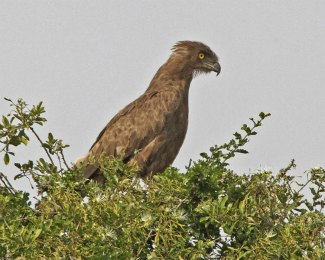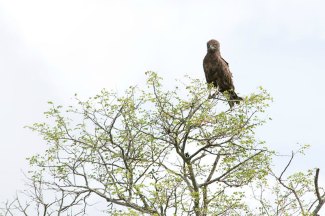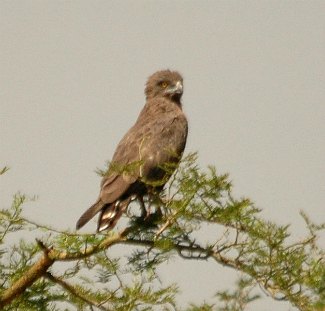Brown Snake Eagle - Circaetus cinereus
By Lip Kee, CC-BY-SA-2.0, via Wikimedia Commons
Family: Accipitridae
Genus: Circaetus
Species: C. cinereus
Brown Snake Eagles are the largest of all snake eagles. They live in dry habitats, with a range spanning much of western, eastern, and southern Africa.
Physical Description:
Brown Snake Eagles are, as their name indicates, almost entirely brown. The head and body are dark brown, while the flight feathers are mottled white and the underwing is gray. The tail is brown with narrow white barring and a white tip. The cere, long bare legs, and feet are pale gray. The beak is black, and the eyes are yellow.
Juveniles are similar to adults but are sometimes lighter in color, and the bases of their feathers are often white.
Brown Snake Eagles are quiet birds, only vocalizing in flight, during displays, or when carrying a snake. Calls are a hoarse "hok hok hok" and a softer "kwee oo" when around the nest. Much of their time is spent perched in a tree or at another high place such as an electricity pylon. They rarely glide or hover when flying.
They live up to 7 years.
Size:
Length: 68-75 cm
Wingspan: 164 cm
Weight: 1.5-2.5 kg
By Chris Eason, CC-BY-2.0, via Wikimedia Commons
Habitat and Distribution:
They live in arid open and dense woodland, at 0-2,500 meters above sea level. They tend to prefer habitat more densely wooded than Circaetus pectoralis (Black-Chested Snake Eagle), and they do not live in lowland forest areas, also avoiding treeless country and desert.
Brown Snake Eagles live across Africa, from Mauritania and Senegal east to Sudan and Ethiopia and south through Angola, Zambia, and Malawi to South Africa, a total range that spans from 18°N to 29°S. They are irruptive or local migrants: In western Africa, they move north during the rainy season following the water and south during the dry season. Juveniles disperse from breeding areas. There are approximately 10,000-100,000 individuals, over 3,880,000 km².
Diet and Hunting:
Most of their diet is snakes, though they eat other animals such as lizards, guineafowl and similar birds, and small mammals. Brown Snake Eagles take snakes up to 2.8 meters long, and often hunt venomous ones—they crush the head of any snake they catch to discharge venom, and they have thick, scaly skin on their legs for protection from bites. Despite those defenses, spitting cobras have been known to blind them.
They hunt by swooping down from a perch and catching their prey on the ground. Unlike other snake eagles, they rarely or never eat in flight.
Reproduction:
Breeding displays consist of dives and soars, and are usually done by only one bird. Pairs may have fairly large territories of up to 200 km².
Egg-laying season is year-round. A stick nest 60-70 cm wide and 15-30 cm deep is built and set 3.5-12 meters above the ground, or the nest of another bird (such as Aquila rapax (Tawny Eagle), Aquila wahlbergi (Wahlberg’s Eagle), Aquila spilogaster (African Hawk Eagle), or Polyboroides typus (African Harrier Hawk)) is used. The nest is lined with green leaves.
By Aviceda, CC-BY-SA-3.0, via Wikimedia Commons
Clutch size is 1 egg, and it is incubated by the female for 48-53 days. Newly-hatched chicks are snow white and take 96-113 days to fledge. They are fully independent of their parents two weeks to one month after fledging.
Conservation:
Brown Snake Eagles have a large range and are thinly distributed. They are not threatened in southern Africa, although they live in higher numbers in protected areas, indicating that there is some habitat destruction and human disturbance. The population appears stable, and they are currently listed as Least Concern by BirdLife International.
Taxonomy:
Species within the genus Circaetus form a monophyletic group, and Circaetus is a sister species to the Aegypiinae group of Old World vultures.
Other Names:
Brown Harrier Eagle, Bruinslangarend (Afrikaans), Tõmmu-madukotkas (Estonian), Mørk Slangeørn (Danish), Ruskoköörmekotka (Finnish), Circaète brun (French), Einfarb-Schlangenadler (German), Biancone cenerino (Italian), Chairochouhiwashi (Japanese), Ekangakodi (Kwangali), Brunslangeørn (Norwegian), Gadozer brunatny (Polish), Culebrera Sombria (Spanish), Brun ormörn (Swedish), Ghama (Tsonga).
Other Multimedia:
References:
http://avibase.bsc-eoc.org/species.jsp?avibaseid=6904D83FD07E202F
http://www.biodiversityexplorer.org/birds/accipitridae/circaetus_cinereus.htm
BirdLife International (2011) Species factsheet: Circaetus cinereus. Downloaded from http://www.birdlife.org on
27/10/2011.
Global Raptor Information Network. 2011. Species account: Brown Snake Eagle Circaetus cinereus. Downloaded from
http://www.globalraptors.org on 27 Oct. 2011
BirdLife International 2009. Circaetus cinereus. In: IUCN 2011. IUCN Red List of Threatened Species. Version 2011.1.
www.iucnredlist.org. Downloaded on 27 October 2011.
http://www.kenyabirds.org.uk/b_snake.htm
http://www.planetofbirds.com/accipitriformes-accipitridae-brown-snake-eagle-circaetus-cinereus
Ferguson-Lees, James, and Christie, David A. Raptors of the World. Houghton Mifflin Company, 2001.


